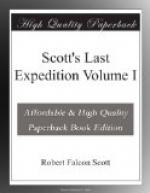Bowers insists on doing all camp work; he is a positive wonder. I never met such a sledge traveller.
The sastrugi all across the strait have been across, the main S. by E. and the other E.S.E., but these are a great study here; the hard snow is striated with long wavy lines crossed with lighter wavy lines. It gives a sort of herringbone effect.
After depositing this extra load we proceeded up the Ferrar Glacier; curious low ice foot on left, no tide crack, sea ice very thinly covered with snow. We are getting delightfully fit. Bowers treasure all round, Evans much the same. Simpson learning fast. Find the camp life suits me well except the turning out at night! three times last night. We were trying nose nips and face guards, marching head to wind all day.
We reached Cathedral Rocks on the 19th. Here we found the stakes placed by Wright across the glacier, and spent the remainder of the day and the whole of the 20th in plotting their position accurately. (Very cold wind down glacier increasing. In spite of this Bowers wrestled with theodolite. He is really wonderful. I have never seen anyone who could go on so long with bare fingers. My own fingers went every few moments.)We saw that there had been movement and roughly measured it as about 30 feet. (The old Ferrar Glacier is more lively than we thought.) After plotting the figures it turns out that the movement varies from 24 to 32 feet at different stakes—this is 7 1/2 months. This is an extremely important observation, the first made on the movement of the coastal glaciers; it is more than I expected to find, but small enough to show that the idea of comparative stagnation was correct. Bowers and I exposed a number of plates and films in the glacier which have turned out very well, auguring well for the management of the camera on the Southern journey.
On the 21st we came down the glacier and camped at the northern end of the foot. (There appeared to be a storm in the Strait; cumulus cloud over Erebus and the whalebacks. Very stormy look over Lister occasionally and drift from peaks; but all smiling in our Happy Valley. Evidently this is a very favoured spot.) From thence we jogged up the coast on the following days, dipping into New Harbour and climbing the moraine, taking angles and collecting rock specimens. At Cape Bernacchi we found a quantity of pure quartz in situ, and in it veins of copper ore. I got a specimen with two or three large lumps of copper included. This is the first find of minerals suggestive of the possibility of working.
The next day we sighted a long, low ice wall, and took it at first for a long glacier tongue stretching seaward from the land. As we approached we saw a dark mark on it. Suddenly it dawned on us that the tongue was detached from the land, and we turned towards it half recognising familiar features. As we got close we saw similarity to our old Erebus Glacier Tongue, and finally caught sight of a flag




